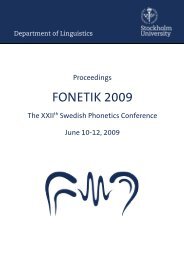The Double Passive in Swedish - Institutionen för lingvistik ...
The Double Passive in Swedish - Institutionen för lingvistik ...
The Double Passive in Swedish - Institutionen för lingvistik ...
You also want an ePaper? Increase the reach of your titles
YUMPU automatically turns print PDFs into web optimized ePapers that Google loves.
<strong>The</strong> <strong>Double</strong> <strong>Passive</strong> <strong>in</strong> <strong>Swedish</strong><br />
A case of creat<strong>in</strong>g rais<strong>in</strong>g verbs <strong>in</strong> the Scand<strong>in</strong>avian languages.<br />
Abstract<br />
<strong>The</strong> primary aim of this thesis is to map the syntactic and semantic nature, and the frequency of the<br />
<strong>Double</strong> <strong>Passive</strong> <strong>in</strong> <strong>Swedish</strong> – this due to the fact that little research regard<strong>in</strong>g <strong>Double</strong> <strong>Passive</strong><br />
constructions <strong>in</strong> <strong>Swedish</strong> has been done. In the thesis Lexical functional grammar (LFG) is used as a<br />
model for semantic and syntactic analysis. <strong>The</strong> analysis showed that when the AGENT <strong>in</strong> a <strong>Double</strong><br />
<strong>Passive</strong> construction is suppressed, it creates an argument structure that triggers an equi verb to occur<br />
as a rais<strong>in</strong>g verb (cf. Ørsnes, 2006). Overt agents with<strong>in</strong> constructions conta<strong>in</strong><strong>in</strong>g the <strong>Double</strong> <strong>Passive</strong><br />
showed an even lower frequency than the low frequencies documented <strong>in</strong> previous research <strong>in</strong> passive<br />
voice by Silén (1997) and Laanemets (2010). <strong>The</strong> lower frequency is a result of the fact that a non-<br />
overt agent <strong>in</strong> a <strong>Double</strong> <strong>Passive</strong> construction is suppressed twice. <strong>The</strong> results of a corpus study showed<br />
a frequency of 3.57 % of overt agents with<strong>in</strong> constructions conta<strong>in</strong><strong>in</strong>g <strong>Double</strong> <strong>Passive</strong>s. <strong>The</strong><br />
complementizer ‘att’ (‘to’) <strong>in</strong> the subord<strong>in</strong>ated <strong>in</strong>f<strong>in</strong>itive clause of a <strong>Double</strong> <strong>Passive</strong> is overtly<br />
expressed, partly depend<strong>in</strong>g on the degree of modality of the matrix verb (cf. Sundman, 1983;<br />
Teleman, 1999; Lagerwall, 1999), and the degree of semantic bond<strong>in</strong>g between the matrix verb and<br />
the complement (Givón, 2001b). <strong>The</strong> data (matrix verbs) collected <strong>in</strong> the corpus study was analysed<br />
accord<strong>in</strong>g to a categoris<strong>in</strong>g-system <strong>in</strong> SAG (Teleman, 1999) and <strong>in</strong> Givón (2001a) and Givón (2001b).<br />
<strong>The</strong> matrix verbs with strong nom<strong>in</strong>al (lexical) properties, e.g. ‘planera’ (‘plan’), showed a high<br />
frequency of occurrence with full <strong>in</strong>f<strong>in</strong>itives, as compared to matrix verbs with largely grammatical<br />
mean<strong>in</strong>g, e.g. ‘avse’ (<strong>in</strong>tend’).<br />
Keywords<br />
<strong>Double</strong> <strong>Passive</strong>, Complex <strong>Passive</strong>, control, equi, rais<strong>in</strong>g, agent, <strong>in</strong>f<strong>in</strong>itival complement,<br />
complementizer, LFG.<br />
3

















